Elica NUAGE SENSE DRYWALL-F-75, NUAGE SENSE PAINTABLE-F-75 User Manual

IT |
Istruzioni di montaggio e d'uso |
EN |
Instruction on mounting and use |
DE |
Montageund Gebrauchsanweisung |
FR |
Prescriptions de montage et mode d’emploi |
NL |
Montagevoorschriften en gebruiksaanwijzingen |
ES |
Montaje y modo de empleo |
PT |
Instruções para montagem e utilização |
EL |
Ο∆ΗΓΙΕΣ ΣΥΝΑΡΜΟΛΟΓΗΣΗΣ ΚΑΙ ΧΡΗΣΗΣ |
SV |
Monteringsoch bruksanvisningar |
FI |
Asennusja käyttöohjeet |
NO |
Instrukser for montering og bruk |
DA |
Brugerog monteringsvejledning |
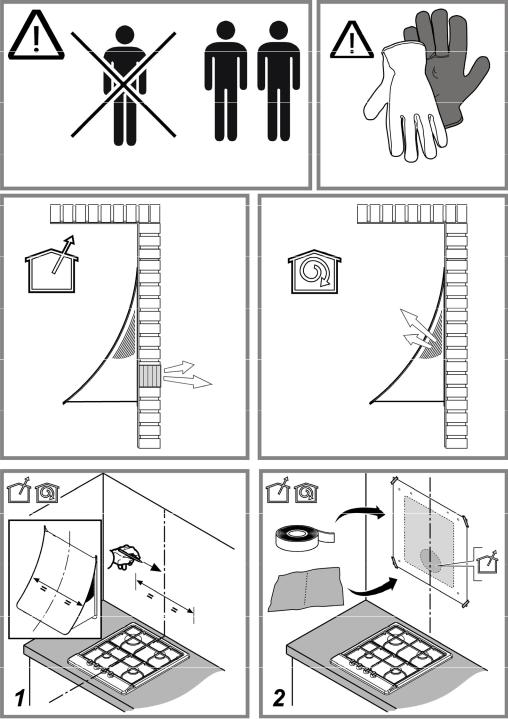
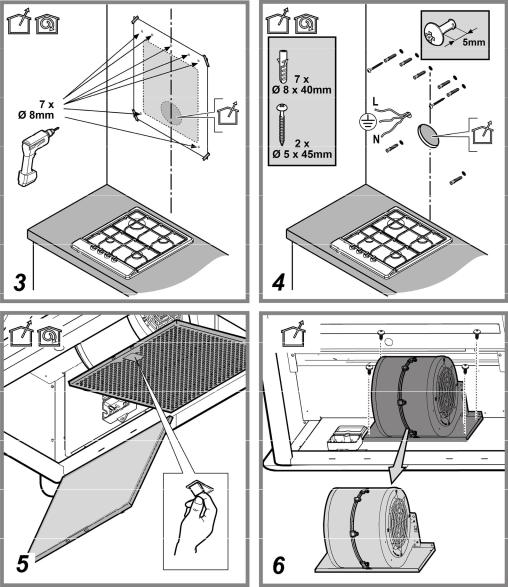
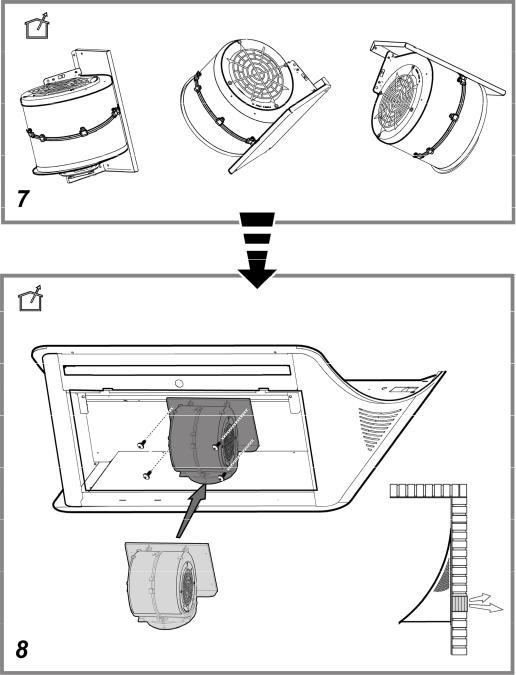
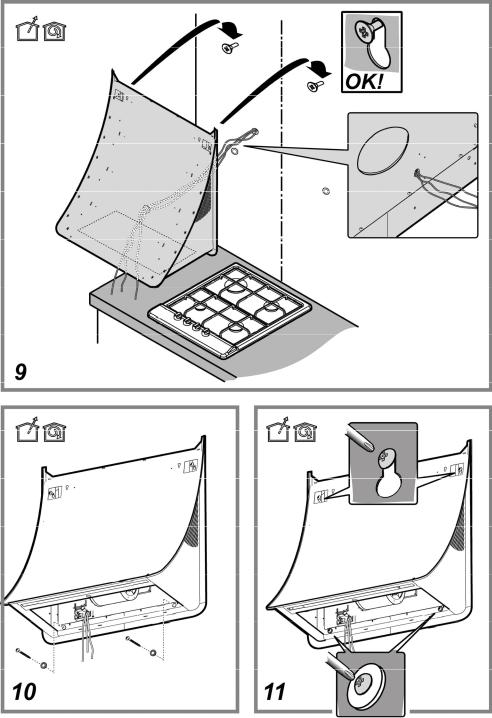
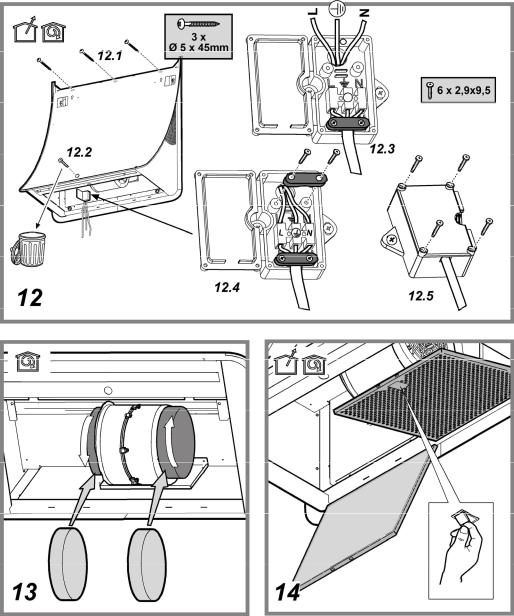
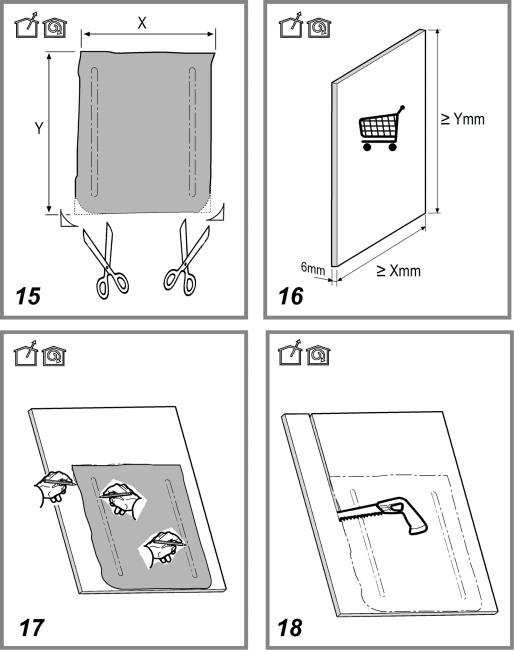


IT - Istruzioni di montaggio e d'uso
Attenersi strettamente alle istruzioni riportate in questo manuale. Si declina ogni responsabilità per eventuali inconvenienti, danni o incendi provocati all'apparecchio derivati dall'inosservanza delle istruzioni riportate in questo manuale. La cappa è concepita per l'aspirazione dei fumi e vapori della cottura ed è destinata al solo uso domestico.
La garanzia sul prodotto non sarà efficace in caso di difetti estetici imputabili e/o derivanti da una non corretta e inadeguata installazione del cartongesso da porre a completamento del prodotto, essendo l'applicazione del cartongesso un'attività di competenza e sotto la piena responsabilità di soggetto terzo diverso dal Produttore.
!E' importante conservare questo manuale per poterlo consultare in ogni momento. In caso di vendita, di cessione o di trasloco, assicurarsi che resti insieme al prodotto.
!Leggere attentamente le istruzioni: ci sono importanti informazioni sull'installazione, sull'uso e sulla sicurezza.
!Non effettuare variazioni elettriche o meccaniche sul prodotto o sulle condotte di scarico.
!Prima di procedere nell'installazione dell'apparecchio verificare che tutti i componenti non siano danneggiati. In caso contrario contattare il rivenditore e non proseguire
con l'installazione.
Nota: I particolari contrassegnati con il simbolo "(*)" sono accessori opzionali forniti solo in alcuni modelli o particolari non forniti, da acquistare.
 Avvertenze
Avvertenze
Prima di qualsiasi operazione di pulizia o manutenzione, disinserire la cappa dalla rete elettrica togliendo la spina o staccando l’interruttore generale dell’abitazione.
Per tutte le operazioni di installazione e manutenzione utilizzare guanti da lavoro. L’apparecchio può essere utilizzato da bambini di età non inferiore a 8 anni e da persone con ridotte capacità fisiche, sensoriali o mentali, o prive di esperienza o della necessaria conoscenza, purchè sotto sorveglianza oppure dopo che le stesse abbiano ricevuto istruzioni relative all’uso sicuro dell’apparecchio e alla comprensione dei pericoli ad esso inerenti.
I bambini devono essere controllati affinché non giochino con l’apparecchio. La pulizia e la manutenzione non deve essere effettuata da bambini senza sorveglianza.
Il locale deve disporre di sufficiente ventilazione, quando la cappa da cucina viene utilizzata contemporaneamente ad altri apparecchi a combustione di gas o altri combustibili.
La cappa va frequentemente pulita sia internamente che esternamente (ALMENO UNA VOLTA AL MESE), rispettare comunque quanto espressamente indicato nelle istruzioni di manutenzione riportate in questo manuale.
L’inosservanza delle norme di pulizia della cappa e della sostituzione e pulizia dei filtri comporta rischi di incendi.
E’ severamente vietato fare cibi alla fiamma sotto la cappa.
L’impiego di fiamma libera è dannoso ai filtri e può dar luogo ad incendi, pertanto deve essere evitato in ogni caso.
La frittura deve essere fatta sotto controllo onde evitare che l’olio surriscaldato prenda fuoco.
ATTENZIONE: Quando il piano di cottura è in funzione le parti accessibili della cappa possono diventare calde.
Per la sostituzione della lampada utilizzare solo il tipo lampada indicato nella sezione manutenzione /sostituzione lampada di questo manuale. Attenzione! Non collegare l’apparecchio alla rete elettrica finche l’installazione
9
non è totalmente completata.
Per quanto riguarda le misure tecniche e di sicurezza da adottare per lo scarico dei fumi attenersi strettamente a quanto previsto dai regolamenti delle autorità locali competenti.
L’aria aspirata non deve essere convogliata in un condotto usato per lo scarico dei fumi prodotti da apparecchi a combustione di gas o di altri combustibili. Non utilizzare o lasciare la cappa priva di lampade correttamente montate per possibile rischio di scossa elettrica.
Mai utilizzare la cappa senza griglia correttamente montata!
La cappa non va MAI utilizzata come piano di appoggio a meno che non sia espressamente indicato.
Utilizzare solo le viti di fissaggio in dotazione con il prodotto per l'installazione o, se non in dotazione, acquistare il tipo di viti corretto. Utilizzare la lunghezza corretta per le viti che sono identificati nella Guida all'installazione. In caso di dubbio, consultare il centro di assistenza autorizzato o personale qualificata similare.
ATTENZIONE! La mancata installazione di viti e dispositivi di fissaggio in conformità di queste istruzioni può comportare rischi di natura elettrica.
Si declina ogni responsabilità per eventuali inconvenienti, danni o incendi provocati all’apparecchio derivati dall’inosservanza delle istruzioni riportate in questo manuale.
Questo apparecchio è contrassegnato in conformità alla Direttiva Europea 2002/96/EC, Waste Electrical and Electronic Equipment (WEEE). Assicurandosi che questo prodotto sia smaltito in modo corretto, l'utente contribuisce a prevenire le
potenziali conseguenze negative per l'ambiente e la salute.
Il simbolo  sul prodotto o sulla documentazione di accompagnamento indica che questo prodotto non deve essere trattato come rifiuto domestico ma deve essere consegnato presso l'idoneo punto di raccolta per il riciclaggio di apparecchiature elettriche ed elettroniche. Disfarsene seguendo le normative locali per lo smaltimento dei rifiuti. Per ulteriori informazioni sul trattamento, recupero e riciclaggio di questo prodotto, contattare l'idoneo ufficio locale, il servizio di raccolta dei rifiuti domestici o il negozio presso il quale il prodotto è stato acquistato.
sul prodotto o sulla documentazione di accompagnamento indica che questo prodotto non deve essere trattato come rifiuto domestico ma deve essere consegnato presso l'idoneo punto di raccolta per il riciclaggio di apparecchiature elettriche ed elettroniche. Disfarsene seguendo le normative locali per lo smaltimento dei rifiuti. Per ulteriori informazioni sul trattamento, recupero e riciclaggio di questo prodotto, contattare l'idoneo ufficio locale, il servizio di raccolta dei rifiuti domestici o il negozio presso il quale il prodotto è stato acquistato.
Apparecchiatura progettata, testata e realizzata nel rispetto delle norme sulla:
•Sicurezza: CEI/EN 60335-1; CEI/EN 60335-2-31, CEI/EN 62233.
•Prestazione: CEI/EN 61591; ISO 5167-1; ISO 5167-3; ISO 5168; CEI/EN 60704-1; CEI/EN 60704-2-13; ISO 3741; EN 50564; CEI 62301.
•EMC: EN 55014-1; CISPR 14-1; EN 55014-2; CISPR 14-2; CEI/EN 61000-3-2; CEI/EN 61000-3-3. Suggerimenti per un corretto utilizzo al fine di ridurre l’impatto ambientale: Quando iniziate a cucinare, accendere la cappa alla velocità minima, lasciandola accesa per alcuni minuti anche dopo il termine della cottura. Aumentare la velocità solo in caso di grandi quantità di fumo e vapore, utilizzando la funzione booster solo in casi estremi. Per mantenere ben efficiente il sistema di riduzione degli odori, sostituire, quando è necessario, il/i filtro/i carbone. Per mantenere ben efficiente il filtro del grasso, pulirlo in caso di necessità. Per ottimizzare l’efficienza e minimizzare i rumori, utilizzare il diametro massimo del sistema di canalizzazione indicato in questo manuale.
ATTENZIONE! La mancata installazione di viti e dispositivi di fissaggio in conformità di queste istruzioni può comportare rischi di natura elettrica.
10
Utilizzazione
La cappa è realizzata per essere utilizzata in versione aspirante ad evacuazione esterna o filtrante a ricircolo interno.
 Versione aspirante
Versione aspirante
I vapori vengono evacuati verso l’esterno tramite un tubo di scarico fissato alla flangia di raccordo.
Il diametro del tubo di scarico deve essere equivalente al diametro dell'anello di connessione.
Attenzione! Il tubo di evacuazione non è fornito e va acquistato.
Nella parte orizzontale, il tubo deve avere una leggera inclinazione verso l’alto (10° circa) in modo da poter trasportare l’aria verso l’esterno più facilmente.
Se la cappa è provvista di filtri al carbone, questi devono essere tolti.
Collegare la cappa a tubi e fori di scarico a parete con diametro equivalente all'uscita d'aria (flangia di raccordo). L'utilizzo di tubi e fori di scarico a parete con diametro inferiore determinerà una diminuizione delle prestazioni di aspirazione ed un drastico aumento della rumorosità.
Si declina perciò ogni responsabilità in merito.
!Usare un condotto lungo il minimo indispensabile.
!Usare un condotto con minor numero di curve possibile (angolo massimo della curva: 90°).
!Evitare cambiamenti drastici di sezione del condotto.
!Usare un condotto con l’interno più liscio possibile.
!Il materiale del condotto deve essere approvato normativamente.
 Versione filtrante
Versione filtrante
L’aria aspirata verrà sgrassata e deodorata prima di essere riconvogliata nella stanza. Per utilizzare la cappa in questa versione è necessario installare un sistema di filtraggio aggiuntivo a base di carboni attivi.
Installazione
La distanza minima fra la superficie di supporto dei recipienti sul dispositivo di cottura e la parte più bassa della cappa da cucina deve essere non inferiore a 50cm in caso di cucine elettriche e di 65cm in caso di cucine a gas o miste.
Se le istruzioni di installazione del dispositivo di cottura a gas specificano una distanza maggiore, bisogna tenerne conto.
 Collegamento Elettrico
Collegamento Elettrico
La tensione di rete deve corrispondere alla tensione riportata sull’etichetta caratteristiche situata all’interno della cappa. Se provvista di spina allacciare la cappa ad una presa conforme alle norme vigenti posta in zona accessibile anche dopo l’installazione. Se sprovvista di spina (collegamento diretto alla rete) o la spina non è posta in zona accessibile, anche dopo installazione, applicare un interruttore bipolare a norma che assicuri la disconnessione completa della rete nelle condizioni della categoria di sovratensione III, conformemente alle regole di installazione.
Attenzione! Prima di ricollegare il circuito della cappa all’alimentazione di rete e di verificarne il corretto funzionamento, controllare sempre che il cavo di rete sia stato montato correttamente.
Montaggio
Prima di iniziare con l'installazione:
•Verificare che il prodotto acquistato sia di dimensioni idonee alla zona di installazione prescelta.
•Togliere il/i filtro/i al carbone attivo se forniti (vedi anche paragrafo relativo). Questo/i va/nno rimontato/i solo se si vuole utilizzare la cappa in versione filtrante.
•Verificare che all'interno della cappa non vi sia (per motivi di trasporto) materiale di corredo (ad esempio buste con viti, garanzie etc) , eventualmente va tolto e conservato.
•Se possibile scollegare e rimuovere i mobili sottostanti ed intorno l’area di installazione (parete o soffitto) della cappa in modo da avere una migliore accessibilità. Altrimenti proteggere per quanto possibile i mobili e tutte le parti interessate all'installazione. Scegliere una superficie piatta da coprire con una protezione dove poi appoggiare la cappa e i particolari a corredo.
•Verificare inoltre che in prossimità della zona di installazione della cappa (in zona accessibile anche con cappa montata) sia disponibile una presa elettrica e sia possibile collegarsi ad un dispositivo di scarico fumi verso l'esterno (solo Versione aspirante).
•Eseguire tutti i lavori di muratura necessari (ad es.: installazione di una presa elettrica e/o foro per il passaggio del tubo di scarico).
Attenzione! Prima di collegare la cappa alla rete elettrica.
Nel caso si possegga un piano di cottura Elica:
Eseguire il collegamento elettrico di cappa e piano di cottura Elica contemporaneamente per permettere il collegamento logico tra cappa e piano di cotturan Elica (vedi anche paragrafo "Funzionamento-Regolazione
11
dei parametri per il Funzionamento automaticoCalibrazione del sensore" e "Funzionamento-
Regolazione dei parametri per il Funzionamento automatico-Collegamento logico tra cappa e piano di cottura Elica").
Nel caso NON si possegga un piano di cottura Elica:
In questo caso la cappa dopo essere collegata alla rete tenterà comunque di collegarsi ad un piano di cottura. Attendere che la cappa termini i tentativi di collegamento (5 minuti circa) procedere con la disattivazione del modulo elettronico di collegamento come segue:
A cappa spenta premere contemporaneamente per più di 10 sec, i tasti T1 e T2 (vedi paragrafo Funzionamento), la cappa emette prima un segnale sonoro breve (beepdopo circa 5 sec), poi un segnale sonoro lungo (beeeep) ad indicare l'avvenuta disattivazione (il led L1 si accende in rosso per pochi secondi).
Riattivazione del modulo di collegamento tra cappa e piano di cottura Elica: A cappa spenta premere contemporaneamente per più di 10 sec, i tasti T1 e T2 (vedi paragrafo Funzionamento), la cappa emette prima un segnale sonoro breve (beep - dopo circa a 5 sec), poi un segnale sonoro lungo (beeeep) ad indicare l'avvenuta attivazione (il led L1 si accende in rosso per pochi secondi).
La cappa è dotata di tasselli di fissaggio adatti alla maggior parte di pareti/soffitti. E’ tuttavia necessario interpellare un tecnico qualificato per accertarVi sull’idoneità dei materiali a seconda del tipo di parete/soffitto. La/il parete/soffitto deve essere sufficientemente robusto da sostenere il peso della cappa.
12
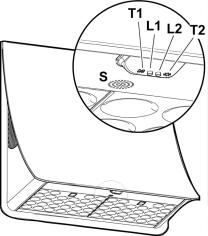
Funzionamento
Usare la velocità maggiore in caso di particolare concentrazione di vapori di cucina. Consigliamo di accendere l'aspirazione 5 minuti prima di iniziare a cucinare e di lasciarla in funzione a cottura terminata per altri 15 minuti circa.
La cappa dispone di un controllo posto sul bordo della cappa e può essere controllata anche con l’apposito telecomando (fornito solo su alcuni modelli).
Pannello di controllo sulla cappa
T1. Tasto di controllo della velocità (potenza) di aspirazione.
Premere ripetutamente fino a selezionare la velocità desiderata tra: Velocità OFF – Led L1: spento
Velocita 1 (aspirazione bassa) – Led L1: luce verde Velocità 2 (aspirazione media) – Led L1: luce gialla Velocità 3 (aspirazione alta) – Led L1: luce celeste
Velocità 4 (aspirazione intensiva) – Led L1: celeste pulsante Nota: La velocità 4 ha una durata limitata di 5 min , dopodichè la cappa passa automaticamente alla velocità 2.
T2. Tasto di controllo illuminazione (luce piano di cottura-luce soffusa) Premere brevemente per l’illuminazione del piano di cottura Premere e mantenere premuto più a lungo per l’illuminazione a luce soffusa.
Nota: L’illuminazione a luce soffusa è disponibile solo in alcuni modelli.
Segnalazione saturazione filtro grassi - Led L1: luce rossa
La segnalazione è visibile per un minuto circa dopo aver spento la cappa.
Quando compare questa segnalazione eseguire la manutenzione del filtro grassi.
Segnalazione saturazione filtro al carbone - Led L1: luce rossa lampeggiante
La segnalazione è visibile per un minuto circa dopo aver spento la cappa.
Quando compare questa segnalazione eseguire la manutenzione del filtro carbone.
Disattivazione/Attivazione segnalazione saturazione filtro al carbone:
Questa segnalazione è normalmente attivata, per disattivarla:
a cappa spenta premere contemporaneamente i tasti T1 e T2 per più di 5 secondi.
Il led L1 si illumina in rosso a luce fissa (segnalazione attiva) per poi iniziare a lampeggiare (segnalazione disattivata).
Ripetere l’operazione se si desidera riattivare la segnalazione, il led L1 da rosso lampeggiante (segnalazione disattiva) si illumina a luce fissa (segnalazione attivata).
Reset segnalazione saturazione filtri
A cappa spenta premere contemporaneamente i tasti T1 e T2 per almeno 5 secondi, il led L1 smette di segnalare la saturazione. Ripetere l’operazione nel caso di segnalazione contemporanea di entrambi i filtri.
Affiliazione telecomando
L'avvenuta affiliazione del telecomando viene visualizzata con entrambi i LED accesi che mostrano in sequenza più colori.
13
Funzionamento automatico (sensore), connessione con
SNAP® e piano di cottura Elica
Attenzione! Si raccomanda di procedere alla "Regolazione dei parametri per il Funzionamento automatico" (vedi paragrafo relativo) prima di utilizzare il funzionamento
automatico e di collegare la cappa allo SNAP® ed al piano di cottura Elica.
Nota: Il funzionamento automatico con il piano di cottura è possibile solo con piani di cottura Elica, per ulteriori dettagli contattare il rivenditore ufficiale o il centro di assistenza tecnica autorizzato.
Funzionamento automatico (sensore)
La cappa si accenderà alla velocità più idonea in base ai fumi di cottura rilevati dal sensore di cui è dotata la cappa.
Per attivare questa funzione:
Premere brevemente i tasti T1 e T2 il LED L1 si illumina mostrando più colori, il LED L2 si illumina in bianco.
Funzionamento automatico della cappa con SNAP®
Nota: Lo SNAP® è una unita di aspirazione ausiliaria in grado di funzionare insieme alla cappa. Per le ulteriori informazioni,
consultare il manuale fornito con lo SNAP® Per attivare questa funzione:
Premere contemporaneamente i tasti T1 e T2 il LED L1 si illumina mostrando più colori, il LED L2 si illumina in arancio.
Funzionamento automatico della cappa con il piano di cottura Elica
Il comportamento della cappa dipenderà anche dall'utilizzo del piano di cottura Elica.
Per attivare questa funzione:
Premere contemporaneamente i tasti T1 e T2 il LED L1 si illumina mostrando più colori, il LED L2 si illumina in blu.
Funzionamento automatico della cappa con SNAP® e piano di cottura
Per attivare questa funzione:
Premere contemporaneamente i tasti T1 e T2 il LED L1 si illumina mostrando più colori, il LED L2 si illumina in arancio.
Regolazione dei parametri per il Funzionamento automatico
Nota: Tutte le operazioni di calibrazione, selezione, regolazione e collegamento logico sotto descritte sono possibili cappa spenta (OFF), e prevedono:
•Calibrazione della cappa (automatica o manuale).
•Selezione del tipo di piano di cottura (gas - induzione o elettrico)
•Collegamento logico tra cappa e piano di cottura (se in possesso di un piano di cottura Elica).
•Collegamento logico tra cappa e SNAP® (se in possesso dello SNAP®).
Calibrazione del sensore
Nota: La calibrazione dura per circa 5 minuti, i LED L1 e L2 lampeggiano in bianco.
La calibrazione è necessaria per permettere al sensore di cui la cappa è dotata di lavorare correttamente e può essere:
Automatica:
ogni qualvolta la cappa viene ricollegata alla rete elettrica (ad es: con la prima installazione o dopo un blackout).
Manuale:
Da eseguire quando si nota un funzionamento insoddisfacente del Funzionamento automatico e va eseguita quando nella cucina persistono condizioni ambientali normali.
Premere a lungo il tasto T1.
Selezione del piano di cottura (gas - induzione o elettrico)
Premere contemporaneamente i tasti T1 e T2 fino ad udire un segnale acustico (beep) rilasciare i tasti e premere nuovamente (entro 5 secondi circa) il solo T2 per entrare nella modalità di scelta del piano di cottura.
Con le successive pressioni sul tasto T2 si può perciò scegliere il piano di cottura desiderato secondo lo schema seguente:
Led 2 arancio: Piano di cottura a gas Led2 blu: Piano di cottura a induzione Led 2 bianco: piano di cottura elettrico
Il tasto prescelto rimane acceso ad indicare l'avvenuta selezione, dopo 10 secondi il tasto lampeggia brevemente ad indicare che la selezione eseguita è stata registrata.
14
Collegamento logico tra cappa e piano di cottura (se in possesso di un piano di cottura Elica).
a.Collegare cappa e piano di cottura Elica contemporaneamente.
b.la cappa emette 2 segnali acustici (beep) ad intermittenza ad indicare che è in grado di ricevere il segnale di collegamento dal piano di cottura Elica.
c.i tentativi di collegamento con il piano di cottura Elica durano circa 5 minuti, entro questo termine la cappa emette 3 segnali acustici (beep) consecutivi ad indicare l'avvenuto collegamento con il piano di cottura Elica.
d.Verificare l'avvenuto collegamento con il piano di cottura Elica: vedi paragrafo "Funzionamento automatico della cappa con il piano di cottura".
Nel caso il collegamento logico tra cappa e piano di cottura Elica non sia riuscito procedere come segue:
Scollegare e ricollegare la cappa dalla rete elettrica almeno 5 volte entro 30 secondi.
Ripetere le operazioni a-b-c-d sopra descritte
Collegamento logico tra cappa e SNAP® (se in possesso dello SNAP®).
Il collegamento tra cappa e SNAP® è automatico. non è necessario eseguire alcuna impostazione.
15

Telecomando
Attenzione! Alcune funzioni di questo telecomando sono attivabili solo con alcuni modelli di cappa.
Affiliazione telecomando:
Premere a lungo T2 +T5 entro il primo minuto di alimentazione della cappa.
L’avvenuta affiliazione sarà visibile sulla cappa.
Descrizione delle funzioni del telecomando
T1. Tasto OFF
T2. Tasto ON/OFF e regolazione intensità luce soffusa
T3. Tasto di controllo della velocità (potenza) di aspirazione:
T4. Tasto ON/OFF luce piano di cottura
T5. Tasto ON/OFF spegnimento della cappa ritardato
T6. Tasto ON/OFF sensore.
T7. Tasto reset segnalazione saturazione filtri.
L3. Led spia di funzionamento del telecomando
Nota: sfiorare i tasti esercitando una leggera pressione per selezionare le funzioni disponibili.
T1. Tasto OFF
Premere per spegnere la cappa
T2. Tasto ON/OFF e regolazione intensità luce soffusa
Premere brevemente per accendere o spegnere la luce soffusa Premere più a lungo per regolarne l’intensità.
Nota: L’illuminazione a luce soffusa è disponibile solo in alcuni modelli.
T3. Tasto di controllo della velocità (potenza) di aspirazione Sfiorare il tasto partendo da qualsiasi posizione esercitando un movimento rotatorio in senso orario o antiorario per aumentare o diminuire la velocità di aspirazione.
Il tasto è diviso in più settori, si può selezionare la velocità desiderata premendo direttamente nel settore corrispondente come segue:
T3a: Velocita 1 (aspirazione bassa) T3b: Velocità 2 (aspirazione media) T3c: Velocità 3 (aspirazione alta)
T3d: Velocità 4 (aspirazione intensiva) T4. Tasto ON/OFF luce piano di cottura
Premere per accendere o spegnere la luce di illuminazione del piano di cottura.
T5. Tasto spegnimento della cappa ritardato:
Premere per programmare lo spegnimento ritardato della cappa in base alla velocità (potenza) di aspirazione attiva in quel momento:
Velocita 1 (aspirazione bassa): 20 minuti Velocità 2 (aspirazione media): 15 minuti Velocità 3 (aspirazione alta): 10 minuti
T6. Tasto ON/OFF sensore.
Premere a lungo per attivare/disattivare la modalità con sensore la quale prevede la gestione dell’aspirazione in modo automatico.
Nota: Il sensore è disponibile solo in alcuni modelli. T7. Tasto reset segnalazione saturazione filtri.
16
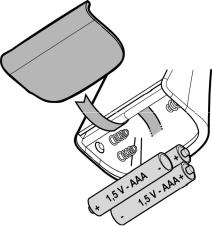
Manutenzione del telecomando
Pulizia del telecomando:
Pulire il telecomando con un panno morbido ed una soluzione detergente neutra priva di sostanze abrasive
Sostituzione della batteria:
•Aprire il vano della batteria.
•Sostituire le batterie esausta con 3 pile nuove da 1,5 V tipo AAA.
Nell' inserire la nuova batteria rispettare le polarità indicate nel vano della batteria!
•Richiudere il vano della batteria.
Smaltimento delle batterie
Lo smaltimento delle batterie deve essere svolto in accordo con tutte le normative e leggi nazionali. Non smaltite le batterie usate assieme ai rifiuti normali.
Le batterie devono essere smaltite in modo sicuro.
Per maggiori ragguagli circa gli aspetti di protezione dell'ambiente, il riciclaggio e lo smaltimento di batterie, contattate gli uffici incaricati della raccolta differenziata.
Attenzione: L’inosservanza delle norme di pulizia dell’apparecchio e della sostituzione dei filtri comporta rischi di incendi. Si raccomanda quindi di attenersi alle istruzioni suggerite.
Si declina ogni responsabilità per eventuali danni al motore, incendi provocati da un’impropria manutenzione o dall’inosservanza delle suddette avvertenze.
Filtro antigrasso
Fig. 5-14
Trattiene le particelle di grasso derivanti dalla cottura.
Deve essere pulito almeno una volta al mese (o quando il sistema di indicazione di saturazione dei filtri - se previsto sul modello in possessoindica questa necessità), con detergenti non aggressivi, in lavastoviglie a basse temperature ed a ciclo breve. (Tmax: 70°C)
Con il lavaggio in lavastoviglie le parti metalliche potrebbero scolorirsi.
Il filtro deve essere asciugato in forno ad una temperatura di max 100°C per un'ora; nel caso in cui il filtro risulti ancora umido ripetere l'operazione.
Sostituire il filtro almeno ogni 2 anni.
Per smontare il filtro grassi tirare la maniglia di sgancio a molla.
Filtro ai carboni attivi (Solo per Versione Filtrante)
Fig. 13
Trattiene gli odori sgradevoli derivanti dalla cottura.
La saturazione del filtro carbone si verifica dopo un uso più o meno prolungato a seconda del tipo di cucina e della regolarità della pulizia del filtro grassi. In ogni caso è necessario sostituire la cartuccia al massimo ogni quattro mesi (o quando il sistema di indicazione di saturazione dei filtri - se previsto sul modello in possessoindica questa necessità).
NON può essere lavato o rigenerato
Filtro al carbone circolare
Applicarne uno per lato a copertura di entrambe le griglie di protezione della girante del motore, dopodiche girare in senso orario.
Per lo smontaggio girare in senso antiorario.
Manutenzione
Attenzione! Prima di qualsiasi operazione di pulizia o manutenzione, disinserire la cappa dalla rete elettrica togliendo la spina o staccando l’interruttore generale dell’abitazione.
Pulizia
La cappa va frequentemente pulita (almeno con la stessa frequenza con cui si esegue la manutenzione dei filtri grassi), sia internamente che esternamente. Per la pulizia usare ESCLUSIVAMENTE un panno inumidito con detersivi liquidi neutri. NON UTILIZZARE UTENSILI O STRUMENTI PER LA
PULIZIA!
Evitare l’uso di prodotti contenenti abrasivi. NON UTILIZZARE
ALCOOL!
Sostituzione Lampade
La cappa è dotata di un sistema di illuminazione basato sulla tecnologia LED.
I LED garantiscono una illuminazione ottimale, una durata fino a 10 volte maggiore delle lampade tradizionali e consentono di risparmiare il 90% di energia elettrica.
Per la sostituzione rivolgersi al servizio assistenza tecnica.
17

EN - Instruction on mounting and use
Closely follow the instructions set out in this manual. All responsibility, for any eventual inconveniences, damages or fires caused by not complying with the instructions in this manual, is declined. The hood is conceived for the suction of cooking fumes and steam and is destined only for domestic use.
The warranty will not be effective in the case of aesthetic defects caused and/or resulting from improper and inadequate installation of plasterboard to be used for product finishing, as its application works is a task to be performed by competent qualified personnel and under the full responsibility of a third party other than the Manufacturer.
!It is important to conserve this booklet for consultation at any moment. In the case of sale, cession or move, make sure it is together with the product.
!Read the instructions carefully: there is important information about installation, use and safety.
!Do not carry out electrical or mechanical variations on the product or on the discharge conduits.
!Before proceeding with the installation of the appliance verify that there are no damaged all components.
Otherwise contact your dealer and do not proceed with the installation.
Note: the elements marked with the symbol “(*)” are optional accessories supplied only with some models or elements to purchase, not supplied.
 Caution
Caution
Before any cleaning or maintenance operation, disconnect hood from the mains by removing the plug or disconnecting the mains electrical supply. Always wear work gloves for all installation and maintenance operations. This appliance can be used by children aged from 8 years and above and persons with reduced physical, sensory or mental capabilities or lack of experience and knowledge if they have been given supervision or instruction concerning use of the appliance in a safe way and understand the hazards involved.
Children shall not be allowed to tamper
with the controls or play with the appliance.
Cleaning and user maintenance shall not be made by children without supervision. The premises where the appliance is installed must be sufficiently ventilated, when the kitchen hood is used together with other gas combustion devices or other fuels.
The hood must be regularly cleaned on both the inside and outside (AT LEAST ONCE A MONTH).
This must be completed in accordance with the maintenance instructions provided in this manual. Failure to follow the instructions provided in this user guide regarding the cleaning of the hood and filters will lead to the risk of fires.
The flaming of foods beneath the hood itself is severely prohibited.
The use of exposed flames is detrimental to the filters and may cause a fire risk, and must therefore be avoided in all circumstances.
Any frying must be done with care in order to make sure that the oil does not overheat and ignite.
CAUTION: Accessible parts of the hood may become hot when used with cooking appliances.
For lamp replacement use only lamp type indicated in the Maintenance/Replacing lamps section of this manual.
WARNING! Do not connect the appliance to the mains until the installation is fully complete.
With regards to the technical and safety
18
measures to be adopted for fume discharging it is important to closely follow the regulations provided by the local authorities.
The ducting system for this appliance must not be connected to any existing ventilation system which is being used for any other purpose such as discharging exhaust fumes from appliances burning gas or other fuels.
Do not use or leave the hood without the lamp correctly mounted due to the possible risk of electric shocks.
Never use the hood without effectively mounted grids.
The hood must NEVER be used as a support surface unless specifically indicated.
Use only the fixing screws supplied with the product for installation or, if not supplied, purchase the correct screws type.
Use the correct length for the screws which are identified in the Installation Guide.
In case of doubt, consult an authorised service assistance centre or similar qualified person.
WARNING! Failure to install the screws or fixing device in accordance with these instructions may result in electrical hazards.
We will not accept any responsibility for any faults, damage or fires caused to the appliance as a result of the nonobservance of the instructions included in this manual.
This appliance is marked according to the European directive 2002/96/EC on Waste Electrical and Electronic Equipment (WEEE). By ensuring this product is disposed of correctly, you
will help prevent potential negative consequences for the environment and human health, which could otherwise be caused by inappropriate waste handling of this product.
The symbol  on the product, or on the documents accompanying the product, indicates that this appliance may not be treated as household waste. Instead it should be taken to the appropriate collection point for the recycling of electrical and electronic equipment. Disposal must be carried out in accordance with local environmental regulations for waste disposal.
on the product, or on the documents accompanying the product, indicates that this appliance may not be treated as household waste. Instead it should be taken to the appropriate collection point for the recycling of electrical and electronic equipment. Disposal must be carried out in accordance with local environmental regulations for waste disposal.
For further detailed information regarding the process, collection and recycling of this product, please contact the appropriate department of your local authorities or the local department for household waste or the shop where you purchased this product.
Appliance designed, tested and manufactured according to:
•Safety: EN/IEC 60335-1; EN/IEC 60335-2-31, EN/IEC 62233.
•Performance: EN/IEC 61591; ISO 5167-1; ISO 5167-3; ISO 5168; EN/IEC 60704-1; EN/IEC 60704-2-13; ISO 3741; EN 50564; IEC 62301.
•EMC: EN 55014-1; CISPR 14-1; EN 55014-2; CISPR 14-2; EN/IEC 61000-3-2; EN/IEC 61000-3-3. Suggestions for a correct use in order to reduce the environmental impact: Switch ON the hood at minimum speed when you start cooking and kept it running for few minutes after cooking is finished. Increase the speed only in case of large amount of smoke and vapour and use boost speed(s) only in extreme situations. Replace the charcoal filter(s) when necessary to maintain a good odour reduction efficiency. Clean the grease filter(s) when necessary to maintain a good grease filter efficiency. Use the maximum diameter of the ducting system indicated in this manual to optimize efficiency and minimize noise.
Additional Installation Specifications:
Use only the fixing screws supplied with the product for installation or, if not supplied, purchase the correct screws type.
Use the correct length for the screws which are identified in the Installation Guide.
In case of doubt, consult an authorised service assistance centre or similar qualified person.
WARNING! Failure to install the screws or fixing device in accordance with these instructions may result in electrical hazards.
19
Use
The hood is designed to be used either for exhausting or filter version.
 Ducting version
Ducting version
In this case the fumes are conveyed outside of the building by means of a special pipe connected with the connection ring located on top of the hood.
Attention! The exhausting pipe is not supplied and must be purchased apart.
Diameter of the exhausting pipe must be equal to that of the connection ring.
In the horizontal runs the exhausting pipe must be slightly slanted (about 10°) and directed upwards to vent the air easily from the room to the outside.
Attention! If the hood is supplied with active charcoal filter, then it must be removed.
Connect the hood and discharge holes on the walls with a diameter equivalent to the air outlet (connection flange). Using the tubes and discharge holes on walls with smaller dimensions will cause a diminution of the suction performance and a drastic increase in noise.
Any responsibility in the matter is therefore declined.
!Use a duct of the minimum indispensible length.
!Use a duct with as few elbows as possible (maximum elbow angle: 90°).
!Avoid drastic changes in the duct cross-section.
!Use a duct as smooth as possible inside.
!The duct must be made of certified material.
 Filter version
Filter version
The aspirated air will be degreased and deodorised before being fed back into the room.
In order to use the hood in this version, you have to install a system of additional filtering based on activated charcoal.
mains under conditions relating to over-current category III, in accordance with installation instructions.
Warning! Before re-connecting the hood circuit to the mains supply and checking the efficient function, always check that the mains cable is correctly assembled.
Mounting
Before beginning installation:
•Check that the product purchased is of a suitable size for the chosen installation area.
•Remove the charcoal (*) filter/s if supplied (see also relative paragraph). This/these is/are to be mounted only if you want lo use the hood in the filtering version.
•Check (for transport reasons) that there is no other supplied material inside the hood (e.g. packets with screws (*), guarantees (*), etc.), eventually removing them and keeping them.
•If possible, disconnect and move freestanding or slide-in range from cabinet opening to provide easier access to rear wall/ceiling. Otherwise put a thick, protective covering over countertop, cooktop or range to protect from damage and debris. Select a flat surface for assembling the unit. Cover that surface with a protective covering and place all canopy hood parts and hardware in it.
•In addition check whether near the installation area of the hood (in the area accessible also with the hood mounted) an electric socket is available and it is possible to connect a fumes discharge device to the outside (only suction version).
•Carry out all the masonry work necessary (e.g. installation of an electric socket and/or a hole for the passage of the discharge tube).
Installation
The minimum distance between the supporting surface for the cooking equipment on the hob and the lowest part of the range hood must be not less than 50cm from electric cookers and 65cm from gas or mixed cookers.
If the instructions for installation for the gas hob specify a greater distance, this must be adhered to.
 Electrical connection
Electrical connection
The mains power supply must correspond to the rating indicated on the plate situated inside the hood. If provided with a plug connect the hood to a socket in compliance with current regulations and positioned in an accessible area, after installation. If it not fitted with a plug (direct mains connection) or if the plug is not located in an accessible area, after installation, apply a double pole switch in accordance with standards which assures the complete disconnection of the
20
Attention! Before connecting the hood to the electrical mains.
If you have an Elica hob:
Perform the electrical connections of the hood and Elica hob at the same time to ensure the logical connection between the hob and Elica hob (also refer to the paragraph "Operation-Adjusting the parameters for automatic operation-Sensor calibration" e "Operation-
Adjusting the parameters for automatic operationLogical connection between hood and Elica hob").
If you do NOT have an Elica hob:
In this case, after being connected to the mains, the hood will try connecting to a hob.
Wait for the hob to complete the connection attempts (approximately 5 minutes) and then disable the electronic connection module as follows:
With the hob switched off, simultaneously press and hold keys T1 and T2 for 10 seconds, (see Operation paragraph), the hood at first emits a short sound signal (beepafter approximately 5 seconds), followed by a long sound signal (beeeep), indicating that the disabling process is complete (LED L1 turns red for a few seconds).
Reactivating the connection module between the hood and Elica hob: With the hob switched off, simultaneously press and hold keys T1 and T2 for 10 seconds, (see Operation paragraph), the hood at first emits a short sound signal (beepafter approximately 5 seconds), followed by a long sound signal (beeeep), indicating that the activation process is complete (LED L1 turns red for a few seconds).
Expansion wall plugs are provided to secure the hood to most types of walls/ceilings. However, a qualified technician must verify suitability of the materials in accordance with the type of wall/ceiling. The wall/ceiling must be strong enough to take the weight of the hood. Do not tile, grout or silicone this appliance to the wall. Surface mounting only.
21
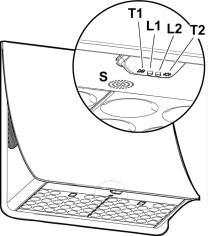
Operation
Use the high suction speed in cases of concentrated kitchen vapours. It is recommended that the cooker hood suction is switched on for 5 minutes prior to cooking and to leave in operation during cooking and for another 15 minutes approximately after terminating cooking.
The hood has an on-board controller which can also be used with the specific remote control (only supplied on some models)
Control panel on hood
T1. Suction speed (power) control key.
Press repeatedly until the desired speed is selected, choosing between:
Speed OFF – LED L1: off
Speed 1 (low suction) – LED L1: green light Speed 2 (medium suction) – LED L1: yellow light Speed 3 (high suction) – LED L1: light blue light
Speed 4 (intensive suction) – LED L1: light blue button
Note: Speed 4 has a limited duration of 5 min., and then the hood passes automatically to speed 2.
T2. Light control key (hob light-dim light) Press briefly to light up the hob
Keep it pressed longer to light up the dim light
Note: The dim light is only available on some models.
Grease filter saturation warning - LED L1: red light
The warning is visible for about one minute after switching the hood off.
When this warning appears, the grease filter requires maintenance.
Charcoal filter saturation warning - LED L1: red light
The warning is available for about one minute after switching the hood off.
When this warning appears, the charcoal filter requires maintenance.
Deactivation/activation of charcoal filter saturation warning:
This warning is normally activated, to deactivate it:
with the hood off, press the keys T1 and T2 simultaneously for more than 5 seconds.
LED L1 lights up red (signal on) and then begins to flash (signal off).
Repeat the operation if you want to reactivate the signal. LED L1 will switch from flashing red (signal off) to remaining lit (signal on).
Filter saturation warning reset
With the hood off, press the keys T1 and T2 simultaneously for at least 5 seconds. The LED L1 will stop signalling saturation.
Repeat the operation in case of simultaneous warnings of both filters.
Pairing the remote control
Once the remote control has been successfully paired both LEDs light up in several colours in sequence.
22
Automatic operation (sensor), connection with SNAP® and Elica hob
Attention! We recommend "Adjusting the parameters for automatic Operation" (see relative paragraph) before using
the automatic operation and connecting the hood to SNAP® and to the Elica hob.
Automatic operation (sensor)
The hood will switch on at an adequate speed depending on the cooking fumes detected by the hood sensor.
To activate this function:
Press keys T1 and T2 simultaneously. LED L1 will light up showing several colours, whereas LED L2 will turn white.
Automatic operation of the hood with SNAP®
Note: SNAP® is an auxiliary suction unit capable of operating together with the hood. For further information, refer to the
manual supplied with SNAP® To activate this function:
Press keys T1 and T2 simultaneously. LED L1 will light up showing several colours, whereas LED L2 will turn orange.
Automatic operation of the hood with the Elica hob
The behaviour of the hood depends on the use of the Elica hob.
To activate this function:
Press keys T1 and T2 simultaneously. LED L1 will light up showing several colours, whereas LED L2 will turn blue.
Automatic operation of the hood with SNAP® and hob
To activate this function:
Press keys T1 and T2 simultaneously. LED L1 will light up showing several colours, whereas LED L2 will turn orange.
Adjusting the parameters for automatic operation.
Note: All the calibration, selection, adjustment, and logical connection operations described below are possible with hood OFF and involve:
•Hood calibration (automatic or manual).
•Hob selection (gas - induction or electrical)
•Logical connection between hood and hob (if in possession of an Elica hob)
•Logical connection between hood and SNAP® (if in possession of SNAP®).
Sensor calibration
Note: Calibration lasts about 5 minutes. LEDs L1 and L2 turn white and flash.
Calibration is required to allow the hood sensor to run properly. Calibration can be:
Automatic:
every time the hood is reconnected to the mains (e.g. upon first installation or after a blackout).
Manual:
To be carried out if unsatisfactory automatic operation is detected and under normal kitchen conditions.
Press and hold key T1..
Hob selection (gas - induction or electrical) Simultaneously press keys T1 and T2 until you hear a beep. Release the keys and press solely T2 (within about 5 seconds) to access the hob selection mode..
Press T2 again to choose the required hob according to the layout below:
Orange LED 2 Gas hob Blue LED 2: Induction hob White LED 2: electrical hob
The selected key remains on to indicate the selection. After 10 seconds, the key flashes temporarily to indicate that the selection made has been recorded.
Logical connection between hood and hob (if in possession of an Elica hob).
a.Connect the hood and Elica hob simultaneously.
b.the hood emits two intermittent beeps to indicate that it is ready to receive the connection signal from the Elica hob.
c.the attempts to connect to the Elica hob last 5 minutes. Within this period, the hood emits 3 consecutive beeps to indicate that the Elica hob has been connected successfully.
d.Check the connection with the Elica hob (see paragraph "Automatic operation of the hood with the hob").
In the event the logical connection between the hood and Elica hob has failed, proceed as follows:
Disconnect and reconnect the hood to the mains at least 5 times within 30 seconds.
Repeat operations a-b-c-d described above
Logical connection between hood and SNAP® (if in the possession of SNAP®).
The connection between hood and SNAP® is automatic. No setting is required.
23

Remote control
Warning! Some functions of this remote control may only be activated with certain hood models.
Remote control affiliation:
Keep T2 +T5 pressed within the first minute the hood is powered.
Once pairing is complete it is displayed on the hood.
Description of the remote control functions
T1. OFF key
T2. ON/OFF key and dim light intensity adjustment
T3. Suction speed (power) control key:
T4. Hob light ON/OFF key
T5. Delayed hood ON/OFF key
T6. Sensor ON/OFF key.
T7. Filter saturation warning reset key.
L3. Remote control operation LED
Note: touch the keys lightly to select the available functions.
T1. OFF key
Press to switch the hood off
T2. ON/OFF key and dim light intensity adjustment Press briefly to switch the dim light on or off Press longer to adjust intensity.
Note: The dim light is only available on some models. T3. Suction speed (power) control key
Touch the key starting from any position, turning it clockwise or anticlockwise to increase or decrease suction speed.
The key is divided into several sectors. You can select the desired speed directly in the corresponding sector as follows: T3a: Speed 1 (low suction)
T3b: Speed 2 (medium suction) T3c: Speed 3 (high suction) T3d: Speed 4 (intensive suction)
T4. Hob light ON/OFF key
Press to switch the hob light on or off. T5. Delayed hood ON/OFF key.
Press to program the delayed switch-off of the hood based on the suction speed (power) active at that moment:
Speed 1 (low suction): 20 minutes Speed 2 (medium suction): 15 minutes Speed 3 (high suction): 10 minutes
T6. Sensor ON/OFF key
Keep it pressed to activate/deactivate the mode with sensor which manages fume extraction in automatic mode.
Note: The sensor is only available in some models. T7. Filter saturation warning reset key.
24
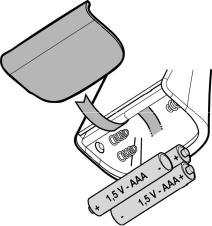
Maintenance of the remote control
Cleaning the remote control:
Clean the remote control with a damp cloth and a neutral solution of detergent without abrasive substances.
Changing the battery:
•Open the battery casing.
•Replace the flat batteries with 3 new 1.5 V type AAA batteries.
Respect the polarity indicated in the battery casing when inserting the new battery!
•Close the battery casing up again.
Disposal of the batteries
Ultimate disposal of the batteries should be handled according to all national laws and regulations. Do not place used batteries in your regular waste.
Ultimate disposal of the batteries must be done safely. Contact your local waste management officials for other information regarding the environmentally sound collection, recycling, and disposal of the batteries.
Maintenance
ATTENTION! Before performing any maintenance operation, isolate the hood from the electrical supply by switching off at the connector and removing the connector fuse.
Or if the appliance has been connected through a plug and socket, then the plug must be removed from the socket.
Cleaning
The cooker hood should be cleaned regularly (at least with the same frequency with which you carry out maintenance of the fat filters) internally and externally. Clean using ONLY the cloth dampened with neutral liquid detergent. DO NOT CLEAN WITH TOOLS OR INSTRUMENTS. Do not use abrasive products. DO NOT USE ALCOHOL!
Warning! Failure to carry out the basic cleaning
recommendations of the cooker hood and replacement of the filters may cause fire risks.
Therefore, we recommend observing these instructions.
The manufacturer declines all responsibility for any damage to the motor or any fire damage linked to inappropriate maintenance or failure to observe the above safety recommendations.
Grease filter
Fig. 5-14
Traps cooking grease particles.
This must be cleaned at least once a month (or when the filter saturation indication system - envisaged on the model in possession - indicates this necessity), using non-aggressive detergents, in a dishwasher, which must be set to a low temperature and a short cycle (Tmax: 70°C).
When washed in a dishwasher, metal parts may discolour slightly.
The filter must be dried in an oven for one hour at a max temperature of 100°C; if the filter is still moist, repeat the operation.
Replace the filter at least every 2 years.
To remove the grease filter, pull the spring release handle.
Charcoal filter (filter version only)
Fig. 13
It absorbs unpleasant odours caused by cooking.
The saturation of the charcoal filter occurs after more or less prolonged use, depending on the type of cooking and the regularity of cleaning of the grease filter.
In any case it is necessary to replace the cartridge at least every four mounths (or when the filter saturation indication system – if envisaged on the model in possession – indicates this necessity).The charcoal filter may NOT be washed or regenerated.
Circular carbon filter
Apply one on each side as cover to both the shield grids of the motor impeller, then turn clockwise.
For the disassembly, turn counter-clockwise.
Replacing lamps
The hood is equipped with a lighting system based on LED technology.
The LEDs guarantee an optimum lighting, a duration up to 10 times as long as the traditional lamps and allow to save 90% electrical energy.
For replacement, contact the technical service.
25

DE - Montageund Gebrauchsanweisung
Die Anweisungen, die in diesem Handbuch gegeben werden, müssen strikt eingehalten werden. Es wird keinerlei Haftung übernommen für mögliche Mängel, Schäden oder Brände der Dunstabzugshaube, die auf die Nichtbeachtung der Vorschriften in diesem Handbuch zurückzuführen sind. Die Dunstabzugshaube wurde für die Absaugung der beim Kochen entstehenden Dünste und Dämpfe entwickelt. Sie ist nur für den Hausgebrauch geeignet.
Die Garantie des Produkts wird nicht wirksam, bei zuzuschreibenden kosmetischen Defekten die durch unsachgemäße Installation der Gipskartonplatten auf die Fertigstellung des Produkts bezogen werden, wobei die Anwendung der Gipskartonplatten Aufgabe der Kompetenz ist und unter der vollen Verantwortung Dritter, nicht der Hersteller, steht.
!Die Bedienungsanleitung muss aufbewahrt werden, damit jederzeit ein Nachschlagen möglich ist. Bei Verkauf, Abtretung oder Umzug muss die Bedienungsanleitung immer beim Produkt bleiben.
!Die Bedienungsanleitung muss aufmerksam gelesen werden, da sie wichtige Informationen über Installation, Gebrauch und Sicherheit enthält.
!Es dürfen keine elektrischen oder mechanischen Änderungen am Gerät oder an den Abluftleitungen vorgenommen werden.
!Vergewissern Sie sich vor der Installation, dass das Gerät keine Transportschäden aufweist. Bei auftretenden Problemen setzen Sie sich bitte mit Ihrem Händler in
Verbindung.
Hinweis: Die mit dem (*) gekennzeichneten Teile sind Zubehörteile, die nur bei einigen Modellen im Lieferumfang enthalten sind oder Teile, die nicht im Lieferumfang enthalten sind, und somit extra erworben werden müssen.
 Warnung
Warnung
Vor jeglicher Reinigung bzw. Wartung, muss das Gerät vom Stromnetz getrennt werden, indem man den Stecker auszieht bzw. den Hauptschalter ausschaltet.
Alle Installations-und Wartungarbeiten sind mit Arbeitshandschuhen durchzuführen.
Das Gerät kann von Kindern ab 8 Jahren, sowie von Menschen mit verringerten physischen, sinnlichen oder psychischen Fähigkeiten (oder ohne Erfahrung und Kenntnisse) benutzt
werden, sofern sie entsprechend überwacht werden bzw. in die Benutzung des Geräts sicher eingewiesen worden und sich den damit verbundenen Gefahren bewusst sind.
Darauf achten, dass Kinder mit dem Gerät nicht spielen. Die Reinigungsund -Wartungsarbeiten müssen von unüberwachten Kindern nicht durchgeführt werden.
Der Raum muss ausreichend belüftet sein, wenn die Dunstabzugshaube zusammen mit anderen Gas-bzw. Brennstoffgeräten verwendet wird.
Die Dunstabzugshaube ist regelmäßig innen und außen zu reinigen: bei der Reinigung ist auf die Wartungshinweise des vorliegenden Handbuchs zu achten.
Das Nichtbeachten der Reiningungshinweise und des Ersatzes bzw. Reinigung der Filter kann zur Brandgefahr führen.
Es ist streng verboten, Speisen auf der Flamme unter der Dunstabzugshaube zu kochen. Die Verwendung von offener Flamme schadet den Filtern und kann zu Brandgefahr führen, daher ist die in jedem Fall zu vermeiden.
Das Frittieren muss mit Vorsicht durchgeführt werden, um zu vermeiden, dass das überhitzte Öl Feuer fängt.
ACHTUNG: Ist das Kochfeld in Betrieb, können zugängliche Teile der Dunstabzugshaube heiß werden.
Für den Lampenersatz verwenden Sie nur den Lampentyp, der in dem Absatz Lampenwartung / Ersatz des
26
vorliegenden Handbuchs angegeben wird.
Achtung! Das Gerät nicht an das Stromnetz anschließen, bis die Installation vollständig abgeschlossen ist. Für das Ableiten der Küchengerüche, sich streng an die Voschriften der örtlichen Behörde halten.
Bei gleichzeitigem Betrieb der Dunstabzugshaube im Abluftbetrieb und gasoder brennstoffbetriebenen Geräten darf im Aufstellraum gasoder brennstoffbetriebenen Geräten der Unterdruck nicht größer als 4 Pa (4 x 10-5 bar) sein.
Die Abzugsluft darf nicht in eine Ableitung der Rauch-bzw.Brennstoffgase geleitet werden.
Die Dunstabzugshaube ohne richtig installierte Lampen nicht verwenden bzw. lassen, um Stromschlaggefahr zu vermeiden.
Die Dunstabzugshaube niemals ohne richtig installiertes Gitter verwenden!
Die Dunstabzugshaube darf NIEMALS als Auflagefläche verwendet werden, sofern es nicht ausdrücklich angegeben ist.
Verwenden Sie nur die mit dem Produkt für die Installation mitgelieferten Schrauben, oder, falls nicht im Lieferumfang enthalten, kaufen Sie den richtigen Schraubentyp. Die Länge für die Schrauben verwenden, die im Installationshandbuch angegeben wird. Im Zweifelsfall, fragen Sie Ihren
autorisierten |
Kundendienst oder |
ein |
ähnliches Fachpersonal. |
|
|
ACHTUNG! |
Schrauben |
und |
27
Befestigungselemente, die nicht in Übereinstimmung mit diesen Hinweisen sind, können zur elektrischen Gefährdung führen.
Man haftet nicht für jegliche Probleme, Schäden bzw. Brände, die durch das Nichtbeachten der im vorliegenden Handbuch enthaltenen Hinweise verursacht werden.
In Übereinstimmung mit den Anforderungen der Europäischen Richtlinie 2002/96/EG über Elektround Elektronik-Altgeräte (WEEE) ist vorliegendes Gerät mit einer Kennzeichnung versehen.
Sie leisten einen positiven Beitrag für den Schutz der Umwelt und die Gesundheit des Menschen, wenn Sie dieses Gerät einer gesonderten Abfallsammlung zuführen. Im unsortierten Siedlungsmüll könnte ein solches Gerät durch unsachgemäße Entsorgung negative Konsequenzen nach sich ziehen.
Auf dem Produkt oder der beiliegenden
Produktdokumentation ist folgendes Symbol  einer durchgestrichenen Abfalltonne abgebildet. Es weist darauf hin, dass eine Entsorgung im normalen Haushaltsabfall nicht zulässig ist. Entsorgen Sie dieses Produkt im Recyclinghof mit einer getrennten Sammlung für Elektround Elektronikgeräte. Die Entsorgung muss gemäß den örtlichen Bestimmungen zur Abfallbeseitigung erfolgen.
einer durchgestrichenen Abfalltonne abgebildet. Es weist darauf hin, dass eine Entsorgung im normalen Haushaltsabfall nicht zulässig ist. Entsorgen Sie dieses Produkt im Recyclinghof mit einer getrennten Sammlung für Elektround Elektronikgeräte. Die Entsorgung muss gemäß den örtlichen Bestimmungen zur Abfallbeseitigung erfolgen.
Bitte wenden Sie sich an die zuständigen Behörden Ihrer Gemeindeverwaltung, an den lokalen Recyclinghof für Haushaltsmüll oder an den Händler, bei dem Sie dieses Gerät erworben haben, um weitere Informationen über Behandlung, Verwertung und Wiederverwendung dieses Produkts zu erhalten.
Gerät entwickelt, getestet und hergestellt nach:
•Safety: EN/IEC 60335-1; EN/IEC 60335-2-31, EN/IEC 62233. •Performance: EN/IEC 61591; ISO 5167-1; ISO 5167-3; ISO 5168; EN/IEC 60704-1; EN/IEC 60704-2-13; ISO 3741; EN 50564; IEC 62301.
•EMC: EN 55014-1; CISPR 14-1; EN 55014-2; CISPR 14-2; EN/IEC 61000-3-2; EN/IEC 61000-3-3. Empfehlungen für eine korrekte Verwendung, um die Umweltbelastung zu verringern: Schalten Sie Haube beim Kochbeginn bei kleinster Geschwindigkeit EIN und lassen Sie die Haube einige Minuten nachlaufen, wenn Sie mit dem Kochen fertig sind. Erhöhen Sie die Geschwindigkeit nur bei großen Mengen von Kochdunst und Dampf und benutzen Sie die Intesivstufe(n) nur bei extemen Situationen. Wechseln Sie die Kohlefilter, wenn notwendig, um eine gute Geruchsreduzierung zu gewährleisten. Säubern Sie die Fettfilter, wenn notwendig, um eine gute Fettfilterungseffizienz zu gewährleisten. Verwenden Sie den in der Gebrauchsanweisung angegebenen grössten Durchmesser des
Luftaustrittssystems, um die Leistungsfähigkeit zu optimieren und die Geräuschentwicklung zu minimieren.
WARNUNG! Erfolgt die Installation der Schrauben oder Befestigungsvorrichtungen nicht entsprechend den vorliegenden Anweisungen, führt dies zu Gefahr durch Stromschlag.
Betriebsart
Die Haube kann sowohl als Abluftgerät als auch als Umluftgerät eingesetzt werden.
 Abluftbetrieb
Abluftbetrieb
Die Luft wird mit Hilfe eines Rohrs ins Freie geleitet, das am Abluftstutzen angebracht wird.
Das Abluftrohr wird nicht mitgeliefert und muss separat erworben werden.
Das Abluftrohr muss den gleichen Durchmesser wie der Abluftstutzen aufweisen.
Das Abluftrohr auf den waagrechten Strecken leicht nach oben geführt werden (ca. 10%), damit die Luft ungehindert ins Freie abgeleitet werden kann.
Hinweis: Sollte die Dunstabzugshaube mit Aktivkohlefilter versehen sein, so muss dieser entfernt werden.
Die Dunstabzugshaube an Abluftrohre und Abluftöffnungen in der Wand anschließen, die den gleichen Durchmesser haben wie der Abluftstutzen (Anschlussflansch).
Die Benutzung von Rohren und Abluftöffnungen mit geringerem Durchmesser verursacht eine Verringerung der Abluftleistung und eine drastische Zunahme der Geräuschentwicklung.
Bei Nichtbeachtung der Anweisungen übernimmt der Hersteller keine Haftung.
!Ein möglichst kurzes Rohr verwenden.
!Ein Rohrsystem mit einer möglichst geringen Anzahl von Krümmungen verwenden (max. Winkel der Krümmung: 90°).
!Starke Änderungen des Rohrdurchmessers sind zu vermeiden.
!Die Innenfläche der Rohrs muss so glatt wie möglich sein.
!Verwenden Sie ausschließlich Rohre aus zugelassenen Materialien.
 Umluftbetrieb
Umluftbetrieb
Die angesaugte Luft wird zuvor entfettet und desodoriert werden, bevor sie wieder in den Raum zugeführt wird.
Um die Abzugshaube in dieser Version zu verwenden, müssen Sie ein zusätzliches Filtersystem, welches auf Aktivkohle basiert, installieren.
Befestigung
Der Abstand zwischen der Abstellfläche auf dem Kochfeld und der Unterseite der Dunstabzugshaube darf 50cm im Fall von elektrischen Kochfeldern und 65cm im Fall von Gasoder kombinierten Herden nicht unterschreiten.
Wenn die Installationsanweisungen des Gaskochgeräts einen größeren Abstand vorgeben, ist dieser zu berücksichtigen.
 Elektrischer Anschluss
Elektrischer Anschluss
Die Netzspannung muss der Spannung entsprechen, die auf dem Betriebsdatenschild im Innern der Haube angegeben ist. Sofern die Haube einen Netzstecker hat, ist dieser an zugänglicher Stelle an eine den geltenden Vorschriften entsprechende Steckdose nach der Montage anzuschließen. Bei einer Haube ohne Stecker (direkter Netzanschluss) oder falls der Stecker nicht zugänglich ist, ist ein normgerechter zweipoliger Schalter nach der Montage anzubringen, der unter Umständen der Überspannung Kategorie III entsprechend den Installationsregeln ein vollständiges Trennen vom Netz garantiert.
Hinweis! Vor der Inbetriebnahme muss sichergestellt werden, dass die Netzversorgungleitung (Steckdose) ordnungsgemäß montiert wurde.
Montage
Bevor Sie mit der Montage beginnen:
•Überprüfen Sie, dass das erstandene Produkt von der Größe her dem Bereich entspricht, in dem es angebracht werden soll.
•Entfernen Sie den/die Aktivkohlefilter (*), falls vorhanden (siehe hierzu auch den entsprechenden Absatz "Wartung"). Der/die Aktivkohlefilter wird/werden nur wieder in die Dunstabzugshaube eingesetzt, wenn diese im Umluftbetrieb verwendet werden soll.
•Vergewissern Sie sich, dass sich im Inneren der Dunstabzugshaube (aus Transportgründen) kein im Lieferumfang enthaltenes Material (zum Beispiel Tütchen mit Schrauben (*), die Garantie (*), usw.) befindet; falls vorhanden, entfernen Sie dieses und heben Sie sie auf.
•Falls möglich, entfernen Sie die Möbel unter und um die Dunstabzugshaube herum, um besseren Zugriff auf die hintere Wand/Decke zu haben, wo die Haube angebracht wird. Sonst legen Sie bitte eine Schutzabdeckung auf die Kochplatte, Arbeitsfläche, sowie die Möbel und Wände, um sie vor Schäden oder Schmutz zu schützen. Wählen Sie eine ebene Oberfläche, um die Einheit zusammenzubauen. Decken Sie diese Oberfläche mit einer Schutzfolie ab und legen Sie die Dunstabzugshaube sowie alle im Lieferumfang enthaltenen Teile darauf.
•Vergewissern Sie sich zudem, dass in der Nähe der Fläche, an der die Dunstabzugshaube angebracht werden soll (eine Fläche, die auch nach der Montage der Dunstabzugshaube weiter zugänglich sein muss), eine Steckdose vorhanden ist und es möglich ist, die Dunstabzugshaube an eine Vorrichtung zum Ableiten der
28
Dämpfe ins Freie anzuschließen (nur Abluftbetrieb).
•Führen Sie alle notwendigen Arbeiten durch (z.B.: Einbau einer Steckdose und/oder Anbringen eines Loches für den Durchgang des Abluftrohres).
Achtung! Vor dem Anschluss der Haube am Stromnetz
Falls Sie ein Kochfeld von Elica besitzen:
Den elektrischen Anschluss der Haube und des Kochfeldes Elica gleichzeitig ausführen, um die logische Verbindung zwischen Haube und Kochfeld Elica herstellen zu können (siehe auch Abschnitt "Betrieb-
Einstellung der Parameter für AutomatikbetriebKalibrierung des Sensors" und "Betrieb-Einstellung der Parameter für Automatikbetrieb-Logische Verbindung zwischen Haube und Kochfeld Elica").
Falls Sie KEIN Kochfeld von Elica besitzen:
In diesem Fall wird die Haube nach dem Netzanschluss dennoch versuchen, sich mit der Kochebene zu verbinden.
Abwarten, bis die Haube die Verbindungsversuche beendet (5 Minuten circa) und dann das elektronische Verbindungsmodul wie folgt deaktivieren:
Bei ausgeschalteter Haube mindestens 10 Sekunden lang gleichzeitig die Tasten T1 und T2 drücken (siehe Abschnitt Betrieb); jetzt ertönt zuerst ein kurzes akustisches Signal (beepnach circa 5 Sekunden), dann ein langes akustisches Signal (beeeep), das die erfolgte Deaktivierung anzeigt (die Led L1 schaltet sich für wenige Sekunden rot ein).
Wiederaktivierung des Verbindungsmoduls zwischen Haube und Kochfeld Elica: Bei ausgeschalteter Haube mindestens 10 Sekunden lang gleichzeitig die Tasten T1 und T2 drücken (siehe Abschnitt Betrieb); jetzt ertönt zuerst ein kurzes akustisches Signal (beepnach circa 5 Sekunden), dann ein langes akustisches Signal (beeeep), das die erfolgte Aktivierung anzeigt (die Led L1 schaltet sich für wenige Sekunden rot ein).
Die Abzugshaube ist mit Dübeln ausgestattet, die für die meisten Wände/Decken geeignet sind. Trotzdem sollte ein qualifizierter Techniker hinzugezogen werden, der entscheidet, ob die Materialien für die jeweilige Wand/Decke geeignet sind. Außerdem muß die Wand/Decke das Gewicht der Abzugshaube tragen muss.
29
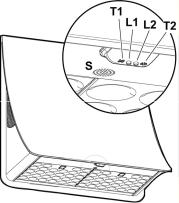
Betrieb
Bei starker Dampfentwicklung die höchste Betriebsstufe einschalten. Es wird empfohlen, die Dunstabzugshaube schon fünf Minuten vor Beginn des Kochvorganges einzuschalten und sie nach dessen Beendigung noch ungefähr 15 Minuten weiterlaufen zu lassen. Die Dunstabzugshaube hat eine Steuerung an ihrem Rand, die auch mit der spezifischen Fernbedienung gesteuert werden kann
(nur auf ein paar Modellen geliefert)
Bedienpult auf der Dunstabzugshaube
T1. Steuerungstaste der Ansauggeschwindigkeit (Leistung).
Wiederholt drücken bis zur Auswahl der gewünschten Geschwindigkeit zwischen:
Geschwindigkeit OFF – LED L1: ausgeschaltet
Geschwindigkeit 1 (niedrige Ansaugung) – LED L1: grünes Licht Geschwindigkeit 2 (mittlere Ansaugung) – LED L1: gelbes Licht Geschwindigkeit 3 (hohe Ansaugung) – LED L1: hellblaues Licht Geschwindigkeit 4 (intensive Ansaugung) – Led L1: hellblaues blinkendes Licht
Anmerkung: Die Geschwindigkeit 4 hat eine begrenzte Dauer von 5 Min., danach geht die Dunstabzugshaube automatisch auf die Geschwindigkeit 2 über.
T2. Steuerungstaste Beleuchtung (Licht Kochfeld - gedämpftes Licht) Für die Beleuchtung des Kochfelds kurz drücken
Für die Beleuchtung mit gedämpftem Licht länger gedrückt halten. Anmerkung: Die Beleuchtung mit gedämpftem Licht ist nur in ein paar Modellen erhältlich.
Meldung Sättigung Fettfilter - LED L1: rotes Licht
Die Meldung ist circa eine Minute lang sichtbar, nachdem die
Dunstabzugshaube ausgeschaltet wurde.
Wenn diese Meldung erscheint , die Wartung des Fettfilters durchführen.
Meldung Sättigung Kohlegeruchfilter - LED L1: rotes Licht blinkt
Die Meldung ist circa eine Minute lang sichtbar, nachdem die Dunstabzugshaube ausgeschaltet wurde.
Wenn diese Meldung erscheint, die Wartung des Kohlegeruchfilters durchführen.
Deaktivierung/Aktivierung der Meldung Sättigung Kohlegeruchfilter:
Diese Meldung ist normalerweise aktiviert, um sie zu deaktivieren:
bei ausgeschalteter Dunstabzugshaube gleichzeitig 5 Sekunden die Tasten T1 und T2 drücken.
Die LED L1 leuchtet rot mit Dauerlicht auf (Meldung aktiviert) und beginnt dann zu blinken (Meldung deaktiviert).
Den Vorgang wiederholen, wenn die Meldung erneut aktiviert werden soll; die LED L1 geht von rot blinkend (Meldung deaktiviert) auf festes Licht (Meldung aktiviert) über.
Rückstellung Meldung Filtersättigung
Bei ausgeschalteter Dunstabzugshaube mindestens 5 Sekunden gleichzeitig die Tasten T1 und T2 drücken, die LED L1 hört auf, die Sättigung zu melden. Bei gleichzeitiger Meldung beider Filter den Vorgang wiederholen.
Aufnahme der Fernbedienung
Die erfolgte Aufnahme der Fernbedienung wird durch Aufleuchten beider
LED, die in Abfolge in mehreren Farben leuchte, angezeigt.
30
